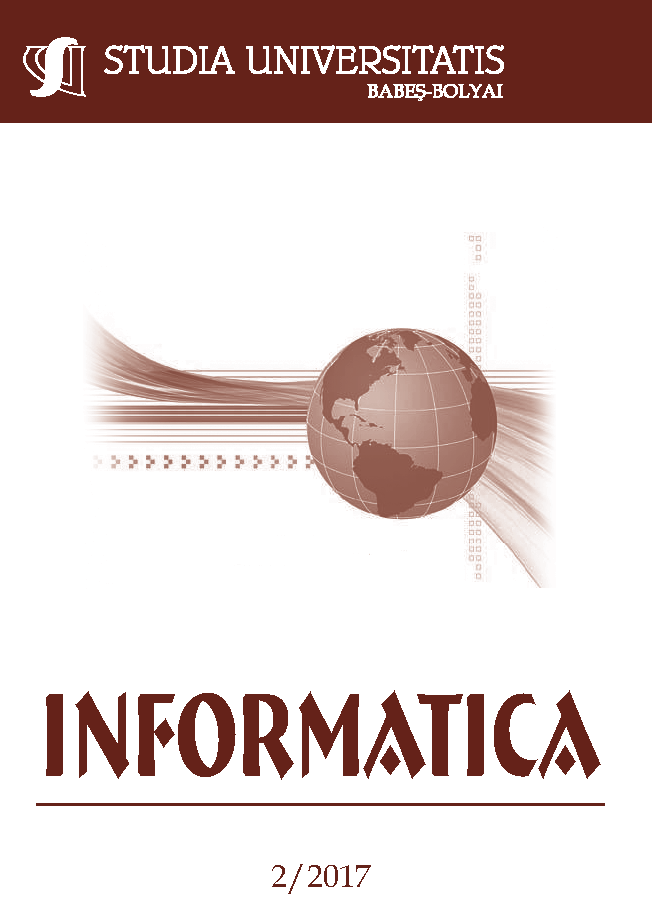ROBBY: A NEUROROBOTICS CONTROL FRAMEWORK USING SPIKING NEURAL NETWORKS
DOI:
https://doi.org/10.24193/subbi.2017.2.07Keywords:
neural simulators, robotic frameworks, cognitive robotics, spiking neural networks.Abstract
The variety of neural models and robotic hardware has made simulation writing time-consuming and error prone, forcing thus scientists to spend a substantial amount of time on the implementation of their models. We developed a framework called “Robby” that allows the quick simulation of large-scale neural networks designed for robotic control by spiking neural networks. It provides both mechanism for robotic communication and tools for building and simulating neural controllers. We present the basic building blocks of “Robby” and a simple experiment to show its practical value.
References
B.P. Gerkey, R.T. Vaughan, K. Stoy, A. Howard, G.S. Sukhatme, and M.J. Mataric. Most Valuable Player: A Robot Device Server for Distributed Control. In Proceedings of the IEEE/RSJ International Conference on Intelligent Robots and Systems, Wailea, Hawaii, 2001.
P. Fitzpatrick, G. Metta, and L. Natale. Towards long-lived robot genes. Robotics and Autonomous Systems, 56(1):29–45, 2008.
D.S. Blank, D. Kumar, L. Meeden, and H. Yanco. Pyro: A python-based versatile programming environment for teaching robotics. Journal of Educational Resources in Computing, 2004.
Bruyninckx H. Open robot control software: the orocos project. 2001.
W. Gerstner and W. Kistler. Spiking neuron models: Single neurons, populations, plasticity. Cambridge University Press, 2002.
R. Haralick and L. Shapiro. Computer and Robot Vision. Addison-Wesley Publishing, 1992.
G. Wolberg and S. Zokai. Robust image registration using log-polar transform. IEEE International Conference on Image Processing, 2000.
M. Hall and J. Mayfield. Improving the Performance of AI Software: Payoffs and Pitfalls in Using Automatic Memoization. Proceedings of the Sixth International Symposium on Artificial Intelligence, Monterrey, Mexico, 1993.
M. Hall and J.P. McNamee. Improving software performance with automatic memoization. Johns Hopkins APL Technical Digest, 18(2), 1997.
R. Chandra, R. Menon, L. Dagum, D. Kohr, D. Maydan, and J. McDonald. Parallel Programming in OpenMP. Morgan Kaufmann, 2000.
E. M. Izhikevich. Simple model of spiking neurons. IEEE Transactions on Neural Networks, 14:1569–1572, 2003.
Brunel N. The evidence for neural information processing with precise spike-times: A survey. Natural Computing, 3:195–206, 2000.
Cessac B and Vieville T. On dynamics of integrate-and-fire neural networks with adaptive conductances. Frontiers in Computational Neuroscience, 2, 2008.
Soula H. Alwan A. and Belson G. Learning at the edge of chaos: Temporal coupling of spiking neuron controller for autonomous robotics. 2005.
L.F. Abbott and W.G. Regehr. Synaptic computation. Nature, 431:796–803, 2004. [16] S. Song, K. D. Miller, and L. F. Abbott. Competitive hebbian learning through spike-timing-dependent synaptic plasticity. Nature Neuroscience, 3:919–926, 2000.
G.G Turrigiano and S. B. Nelson. Homeostatic plasticity in the developing nervous system. Nature Reviews Neuroscience, 5:97–107, 2004.
W. Zhang and D. J. Linden. The other side of the engram: Experience-driven changes in neuronal intrinsic excitability. Nature Reviews Neuroscience, 4:885–900, 2003.
F. Ponulak. ReSuMe-new supervised learning method for Spiking Neural Networks. International Conference on Machine Learning, ICML, 2005.
R. Florian. The chronotron: a neuron that learns to fire temporally-precise spike patterns. PLoS ONE, 7(8), 2012.
R. Florian. Reinforcement learning through modulation of spike-timing-dependent synaptic plasticity. Neural Computation, 19(6):1468–1502, 2007.
Sutton RS and Barto AG. Reinforcement learning. 1998.
Ban T. Fuzzy computing for complexity level of evaluation tests. Studia Universitatis Babes-Bolyai, Seria Informatica, LVIII:81–93, 2013.
Ban T. Generating and assessing test papers complexity using predictions in evolutionary algorithms. 2009.
Downloads
Published
How to Cite
Issue
Section
License
Copyright (c) 2017 Studia Universitatis Babeș-Bolyai Informatica

This work is licensed under a Creative Commons Attribution-NonCommercial-NoDerivatives 4.0 International License.





